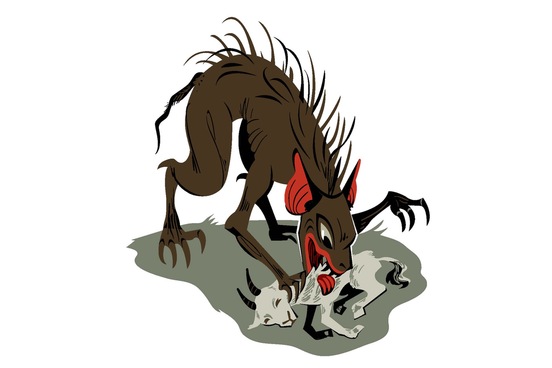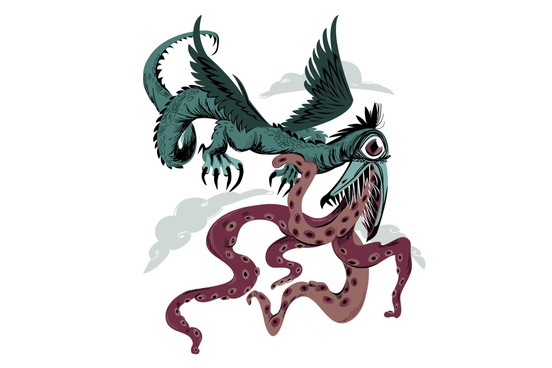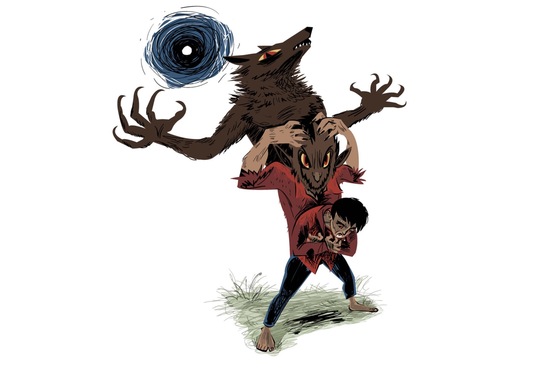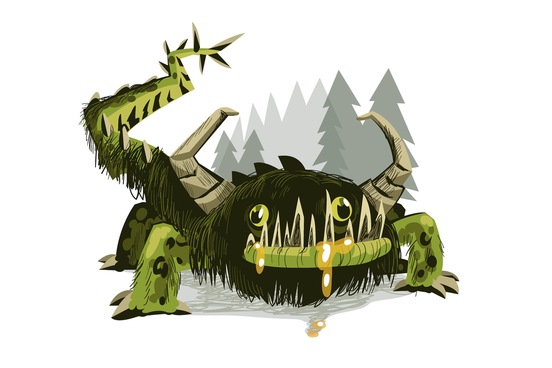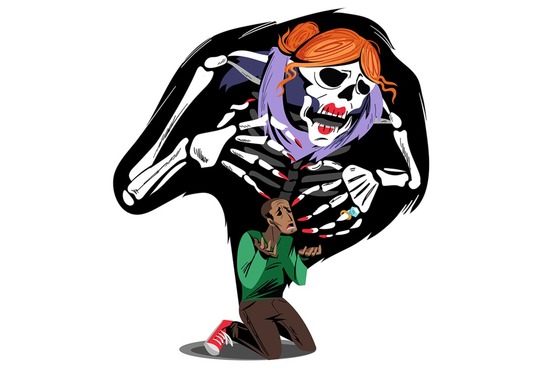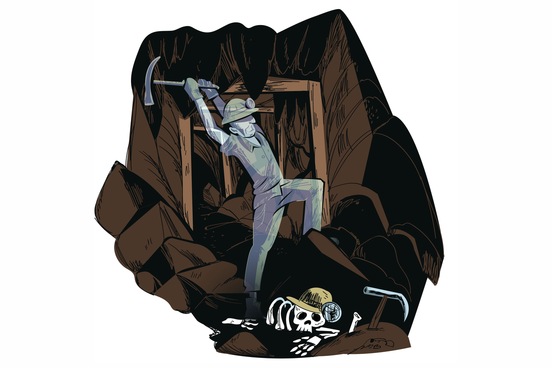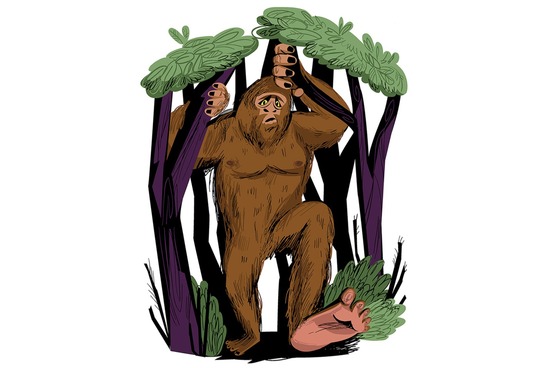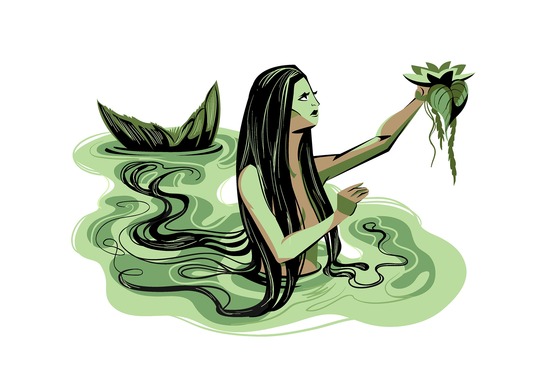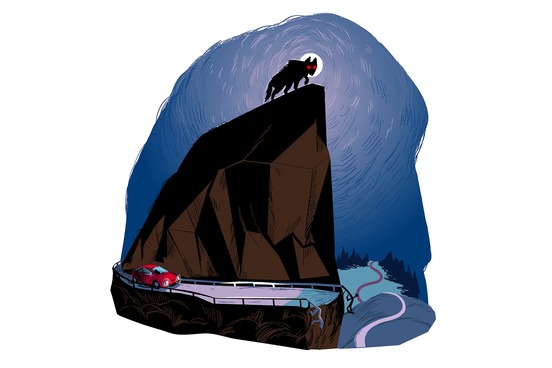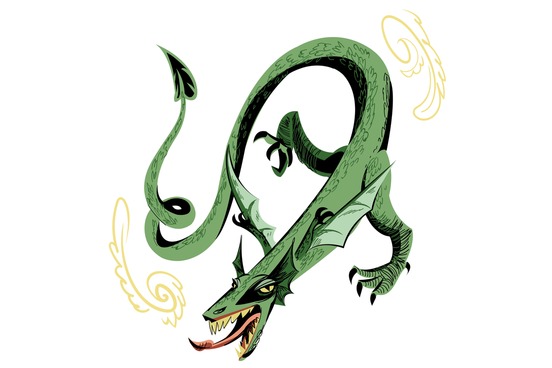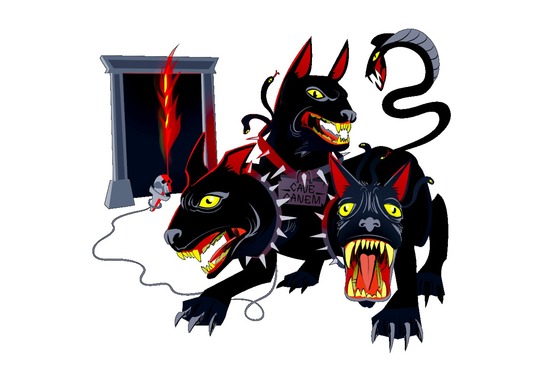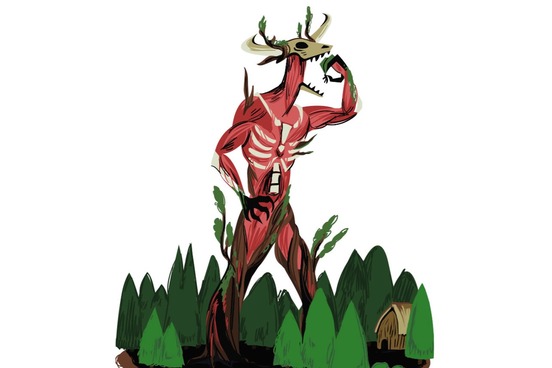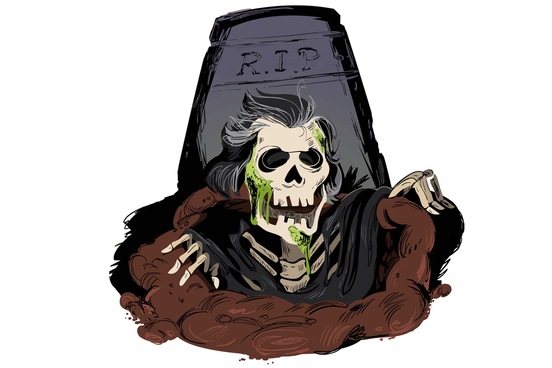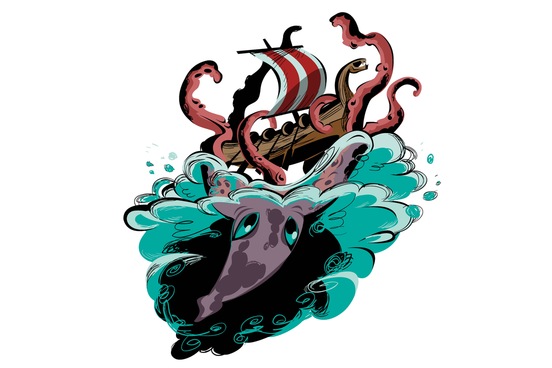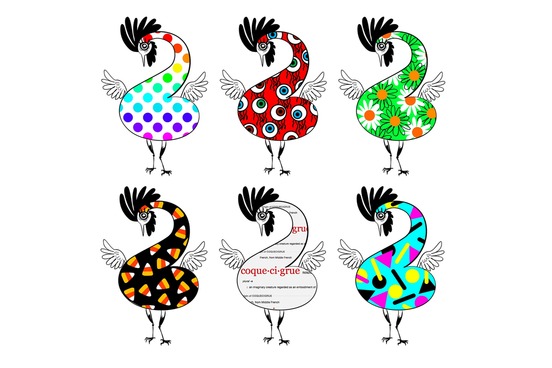Definition: a grotesque creature that drinks the blood of livestock and is reported to exist in North and South America
There’s goatsuckers and then there’s goatsuckers, amirite? Birds like whip-poor-wills and other nightjars are someone times called “goatsuckers” due to the former belief that they suck the milk from goats. Chupacabras on the other hand, are mythical creatures with a taste for caprine blood, not milk—their name comes from a combination of the Spanish words chupa (the third person singular present tense of chupar, meaning “to suck”) and cabra, meaning “goat.”
Like most Americans, I was banking on the solar eclipse ushering in the end times and saving me from the unbearable horrors of a presidential election year and the general absurdity of human existence. But Monday’s much-ballyhooed eclipse came and went and … nothing. … There were literally zero raptures. The earth did not split open and swallow all of humanity into its gaping maw. I briefly thought I saw a chupacabra, but it was just my dog wearing her chupacabra costume.
— Rex Huppke, USA Today, 8 Apr. 2024
Definition: a mythical nocturnal creature that is reported chiefly from rural Maryland, is reputed to be part reptile and part bird, and is said to prey on poultry and children
Hailing from rural western Maryland, snallygasters are famous for two things: (perhaps erroneously inspiring the word snollygoster (“a shrewd, unprincipled person”) and their love of pepperoni rolls (just kidding they eat chicken and children). Snallygaster is thought to perhaps be a modification of Pennsylvania German schnelle geeschter, meaning, literally, “quick spirits.”
For nearly 300 years, Western Maryland has boasted a legend of its own winged beast, called the Snallygaster—reportedly lured to a still in Frog Hollow where it drowned in the moonshine.
— Tamela Baker, The Herald-Mail (Hagerstown, Maryland), 8 Sep. 2023
Definition: a person transformed temporarily or permanently into a wolf or capable of assuming a wolf’s form
Although English sometimes makes use of other words for howling humanoid beasties, werewolf is the leader of the pack. It’s also an ancient word, tracing all the way back to the Old English werwulf, and before that to a prehistoric predecessor that also left its paw prints on German (Werwolf) and Dutch (weerwolf). Synonyms for werewolf in English include the obscure lycanthrope, which has roots in two Greek words (lykos, meaning "wolf," and anthrōpos, meaning "human being"), and loup-garou, which comes from Old French. Whichever you use, the lycanthropic creatures these words refer to most often assume wolf form during a full moon—at least in works of fiction. There are no credible studies to date on the behavior of real-life werewolves, as scientists have yet to find the silver bullet that proves they exist.
For the werewolf, for the werewolf / Have sympathy / Because the werewolf, he is someone / Just like you and me / Once I saw him in the moonlight / When the bats were a-flying / All alone I saw the werewolf / And the werewolf was crying
— Michael Hurley, “Werewolf,” Armchair Boogie (Warner Bros./Raccoon, 1971)
Definition: a mythical animal reported chiefly from Wisconsin and Minnesota, noted for its ugliness, lateral horns, and hooked tail, and reputed to be outstanding in both ferocity and melancholy
If you’re trying to visualize or understand how a creature could be both ferocious and melancholy, just consider how you would feel if your dictionary entry immortalized you as being “noted for its ugliness.” Shed a tear for the upper Midwestern hodag? Oh, you betcha.
Wider Wisconsin learned of the hodag in October 1893 when [Eugene Simeon] Shepard wrote of it in a column in Rhinelander's Near North newspaper. Shepard wrote that he and his friends came across the hodag with their hunting dogs. The creature had the “strength of an ox,” “the ferocity of a bear” and the “cunning of a fox.” It tore apart the dogs and remained undefeated, even after the men shot it with “heavy rifles and large-bore squirt guns loaded with poisonous water.” The men struggled for hours before killing the hodag with dynamite. … Three years after claiming to have blown up the hodag, Shepard wrote that he'd apprehended one again, this time, alive. … In reality, Shepard and a friend had sculpted the creature with wood and smelly hides from a tannery.
— Claire Reid, The Milwaukee Journal Sentinel, 3 Oct. 2023
Definition: an evil spirit or the wandering soul of a dead person believed in Jewish folklore to enter and control a living body until exorcised by a religious rite
Dybbuk comes from the Yiddish word dibbek, which in turn comes from the Late Hebrew dibbūq¬. The first-known use of dybbuk in published English occurred near the turn of the 20th century. As Sala Levin wrote for Moment magazine, “The phenomenon of being overcome by an otherworldly spirit has a long history in Judaism. In the book of Samuel, David rids King Saul of “a spirit of melancholy from God” by playing his harp. The idea of the dybbuk gained traction in the 16th century, when kabbalah, flourishing in the northern Galilee city of Tzfat, promulgated ideas about the afterlife.”
A dybbuk is the wandering soul of a dead person. You don’t want to make the mistake of inviting one into your home. You don’t have to be Jewish to figure that out.
— Roger Ebert, review of the film A Serious Man, 7 Oct. 2009
Definition: the ghost of a man killed in a mine
Get a lode of this: like its fellow the poltergeist, the tommy-knocker is a noisy ghost, though one who haunts a very specific locale: mines. The term was first recorded in the late 1800s in the western United States, and is thought to have arisen from the belief that ole Tommy was responsible for the creaking of timbers late at night in the mines.
When I die (said the mining engineer) do not bury me at all;
Cache me on the bottom level, with a pick beside my pall;
Leave a candlestick and matches, then cave the stopes and drifts,
And I’ll be a tommy-knocker for a hundred thousand shifts.
— Samuel B. Ellis, The Canadian Mining Journal, 8 Oct. 1920
Definition: a hairy creature like a human being that is reported to exist in the northwestern U.S. and western Canada and is said to be a primate between 6 and 15 feet (1.8 and 4.6 meters) tall
Sasquatch comes from sésq̓əc, a word in Halkomelem, a Salishan language of southwestern British Columbia. Its use in English predates its synonym bigfoot by about a half-century. If the thought of this mythical being causes you to ponder whether the descriptor illusive or elusive is apropos, you may want to read this article.
More than 40 fingerprint experts have examined the casts and generally agree they’re authentic. Even anthropologist Vincent Sarich, of the University of California, Berkeley, who says he would bet his life that Sasquatch does not exist, says that “it would be impossible to fake prints with dermal ridges.” But according to a recent survey of professors of anthropology at North American universities, only 12 percent entertain the possibility that Sasquatch exists. “The problem is that Sasquatch does not fit any orthodox theories of primate evolution,” says anthropologist Frank Poirier of Ohio State University, who calls the footprint casts “extremely interesting” but still doubts Sasquatch’s reality.
— Sharon Begley, Newsweek, 21 Sep. 1987
Definition: a supernatural creature originally in Germanic folklore and conceived of in many forms but usually as having the form of a woman or as half human and half fish, dwelling in fresh water usually in a beautiful palace, and usually unfriendly to man
Nix and its variant nixie come from German, and share roots further back with the Old English word nicor, meaning “water monster.” Grindylow is another old English word for a water-dwelling beastie, as is the (quite evocative) Jenny Greenteeth.
One morning he arose before daybreak, and went out into the open air, thinking that it would make him a little lighter at heart; and just as he was strolling along the mill-dam, the first rays of the sun streamed over the fields, and he heard something splashing in the millpond. He turned round and beheld a beautiful woman, rising slowly out of the water. … Then he saw that it must be the Nix or the spirit of the millpond, and in his fright he knew not whether to run away or to remain.
— Jacob and Wilhelm Grimm (trans. by John Edward Taylor), The Fairy Ring: A Collection of Tales and Traditions (1857)
Definition: a specter or ghost especially in the form of an animal
Even if you’ve never heard the word before, we’re sure you’re likely familiar with the concept behind guytrash. No, we don’t mean piles of empty pizza boxes and energy drink bottles (rim shot) but rather a ghostly, supernatural animal. Like the ominous barghest, a guytrash can take the form of a spooky doggo, but it can assume other animal forms as well. The earliest known use of guytrash in print (spelled gytrash) is from 1847, when none other than Charlotte Brontë included it in Jane Eyre.
There is a certain type of phantom that has a definite leaning toward the north of England. It is called a ‘Guytrash’, and takes the form of either a large dog or a riderless horse.
— Peggy Hewitt, These Lonely Mountains: A Biography of the Brontë Moors (Springfield Books, 1985)
Definition: a fabulous animal usually represented as a 2-legged winged creature resembling a dragon Wyverns are often depicted as having the tail of a viper—a venomous snake—and that fact is reflected in the etymology of wyvern: it comes ultimately from the Latin word vipera, the source of the English word viper. The creature the wyvern most closely resembles, however, is the also-mythical dragon. [Dragon](/dictionary/dragon—is a much older word—it’s been in use since the 13th century, while wyvern dates to the early 17th—but it too has herpetologic history. The word originally referred not to the lizard-like creature we imagine today but to a huge serpent.
Wyverns keep a silent watch over the people of Leicester from rooftops and steeples across the city. Their coiled, winged bodies, part serpent part dragon, have been entwined in our ancient history for hundreds of years. If you know where to look you can find them in most Victorian streets, although the most easy to spot sit majestically upon the Town Hall, the Clock Tower and the Corn Exchange.
— The Leicester [United Kingdom] Mercury, 13 June 2014
Definition: a three-headed dog that in Greek mythology guards the entrance to Hades
Cerberus, in Greek mythology, the monstrous watchdog of the underworld. He was usually said to have three heads, though the poet Hesiod said he had 50. Heads of snakes grew from his back, and he had a serpent’s tail. He devoured anyone who tried to escape the kingdom of Hades, the lord of the underworld, and he refused entrance to living humans, though the mythic hero Orpheus gained passage by charming him with music. Cerberus’s patrol of the English language eventually gave rise to the phrase “sop to Cerberus,” referring to a concession or bribe used to pacify someone a person who could otherwise become a problem. The reference is to a passage in Virgil’s Aeneid, when Aeneas slips by Cerberus after giving him a sop as distraction.
Orpheus, son of Apollo, played his lyre so well that birds and beasts were stilled and oak trees moved from their places to listen. Even Cerberus, the three-headed guardian of Hades, was lulled to sleep when the musician tried to bring Eurydice back from the dead.
— Time, 5 Nov. 1934
Definition: a cannibalistic creature of Algonkian mythology believed to have been a lost hunter forced by hunger to eat human flesh
Windigo, also spelled wendigo or wiindigo (as Objibwe poet Heid E. Erdrich writes below), comes from the Ojibwe language, and possibly from the proto-Algonkian word wi-nteko-wa, meaning “owl.” For centuries Indigenous artists and activists have drawn on the windigo legend both literally and metaphorically to address such issues as colonialism, violence, and environmental destruction. In the 21st century, activist Winona LaDuke coined the term Wendigo economics to criticize corporations’ “cannibalistic” effect on Earth.
Some think the Wiindigo quite pretty
in an icy-eyed and blue way.
It can sing, offers irresistible gambles …
you can understand the attraction.
— Heid E. Erdrich, from “Wiindigo Pity,” Cell Traffic: New and Selected Poems (2012)
Definition: a will-less and speechless human (as in voodoo belief and in fictional stories) held to have died and been supernaturally reanimated
Zombie comes from the Louisiana Creole or Haitian Creole word zonbi, which in turn is of Bantu origin. Although the word first appeared in English in the 1870s, it wasn’t the subject of much interest among English speakers until the 1940s when zombie movies like I Walked with a Zombie (1943) and Zombies on Broadway (1945) saw the start of a trend we’re still living with.
“A zombie is supposed to be the living dead: people who die and are resurrected, but without their souls. And they can take orders, and they're supposed to never be tired, and to do what the master says…”
— Zora Neale Hurston, interview, Mary Margaret McBride Show, 25 Jan. 1943
Definition: a gigantic tentacled sea monster of Scandinavian myth
The kraken is a legendary sea monster of Scandinavian and Norwegian lore, perhaps imagined from sightings of giant squids and octopi. Sailors have discussed giant sea monsters for thousands of years, and Danish historian Erik Pontoppidan described the kraken (as well as sea serpents and mermaids) in detail in his Natural History of Norway (first published in Danish in 1752), claiming the beast was “round, flat, and full of arms” and “the largest and most surprising of all the animal creation.”
We still know very little about the “kraken,” the gigantic relative or relatives of the small and medium-sized squids, calamaries, and cuttlefish. And the story of that truly awful monster of the sea is still mostly one that is founded on uncertainty, put together by way of hearsay, designed by the imagination and embroidered and polished by literary splendor. Still and all, the story somehow holds together, mostly because there are some facts. They are scattered and many of them are insufficiently documented, but they are facts. And while a twenty-foot piece of foot-thick tentacle vomited in death struggle by a dying whale can not very well replace the whole giant octopus that went with that piece of tentacle, it at least proves that there is a giant octopus of such size.
— Willy Ley, The Lungfish, the Dodo, & the Unicorn: An Excursion into Romantic Zoology (1948)
Definition: an imaginary creature regarded as an embodiment of absolute absurdity
The word coquecigrue is of French origin—François Rabelais in Gargantua uses the phrase à la venue des coquecigrues to mean “never.” Charles Kingsley later translated that phrase in The Water Babies, when the fairy Bedonebyasyoudid reports that there are seven things he is forbidden to tell until “the coming of the Cocqcigrues.” According to the OED, this creature—also called the cocklicrane) may combine “features of a cockerel or rooster with those of a crane,” owing to the French words coq and grue (“cock” and “crane,” respectively).
Although we’ve reached the end of this list, the dictionary is dark and full of terrors, and you’ll only find an end to the frightful creatures contained therein upon the coming of the Coquecigrue.
Coquecigrue is one of the “fearful wildfowl” of Rabelais’ invention. These hippogriffs and other monsters are painted on the Chinese lanterns hung up in the pastry-cooks’ shops.
— The Journal of Education, 1 Oct. 1893
